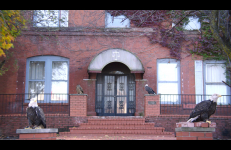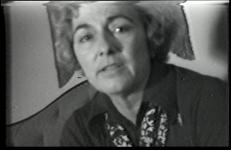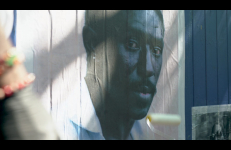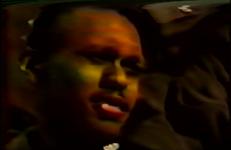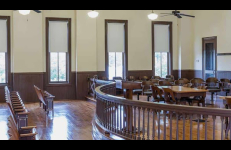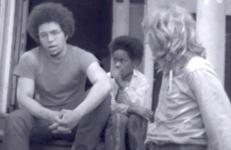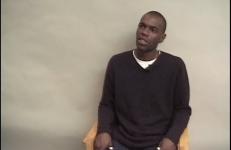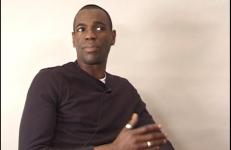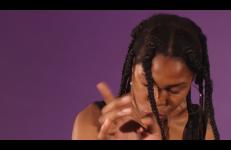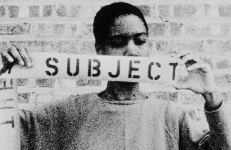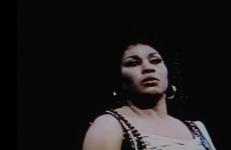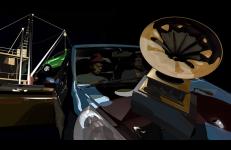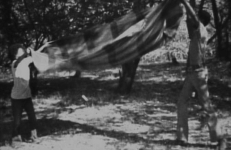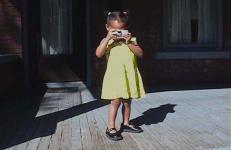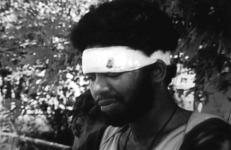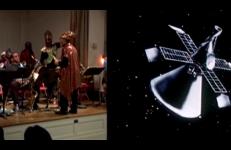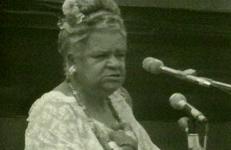"I brought live reptiles, birds of prey and exotic flowers to a very stereotyped and neglected section of the city of St. Louis, Missouri which suffers from from severe abandonment and despair, but also has many tranquil vacant lots where nature flourishes. I chose these birds of prey for their symbolic meaning- The bald eagle a symbol of the United States, hawks and owls are messengers. But this is not a film about St. Louis, It's about an anonymous archetype more than a specific locale. St.
African-American
In October 1969, the Videofreex visited the home of wealthy political and social activist, Lucy Montgomery, as she was hosting the Black Panther Party of Chicago during one of their most fraught times – the period just after Chairman Bobby Seale was wrongfully imprisoned for inciting riots at the Democratic National Convention a year earlier. This video documents an interview with the wife of Bobby Seale, Artie Seale. The video opens with a statement by Mrs.
Commissioned by Visual AIDS for STILL BEGINNING: The 30th Annual Day With(out) Art
My Only Idol is Reality is a video work created from an excerpt of Season One of MTV’s The Real World. The piece uses repetition as a framework for abstraction — re-recording the video between
A sound-essay set in the Tallahatchie County Second District Courtroom in Sumner, Mississippi, mythicPotentialities is an exploration of the event said to have galvanized the civil rights movement in America, the murder of Emmett Till, the trial that followed, and the way these event have been mediated through documentary text like Eyes on the Prize, The Murder of Emmet Till, and numerous other books, plays, poems and articles.
Skip Blumberg of the Videofreex conducts an interview with Charles “Cappy” Pinderhughes, the Lieutenant of Information of the New Haven branch of the Black Panther Party. From the steps of the New Haven headquarters, Cappy publicizes the upcoming Revolutionary Peoples Constitutional Convention set to take place in Washington, D.C. later that week (June 19th, 1970). In addition, Cappy provides a statement to be shared via the Videofreex at the Alternative Media Conference occurring at Godard College in Vermont.
In this 2004 interview, Kori Newkirk (b.1970) describes his lifelong apprehension of being rooted in any one place for too long. Asserting that the School of the Art Institute of Chicago was the fifth school he attended in four years, Newkirk begins by describing the fortuitousness of his relocation to Chicago following his expulsion from Cooper Union. Recounting how he fled from the fiber department in favor of painting, Newkirk details how it was a studio visit from Deborah Kass and an exchange program to England that crystallized his burgeoning ideas about “painting without making paintings.”
In this interview, Kori Newkirk (b.1970) describes his interest in the space that exists between categories. Hailing from the Bronx, earning a BFA at the School of the Art Institute of Chicago (SAIC), and finally settling on Los Angeles as his base of operations, Newkirk has always been motivated by a desire to eschew provincialism. In this conversation, he discusses the idea of regional identity, his complex relationship with the Los Angeles art community, and how his experience as a student at SAIC helped him move beyond the boundaries of a simple material definition of painting.
Using a pulsing rock soundtrack and music video-style editing, X-PRZ combines archival footage of Malcolm X, advertisements, and corporate logos in No Sell Out to provide a scathing commentary on commodity culture.
Using a pulsing rock soundtrack and music video-style editing, X-PRZ combines archival footage of Malcolm X, advertisements, and corporate logos in No Sell Out to provide a scathing commentary on commodity culture.
Inspired by a riff on a popular joke “Everybody wanna be a black woman but nobody wanna be a black woman,” Notes On Gesture is a video comparing authentic and dramatic gestures. The piece uses the 17th Century text Chirologia: Or the Natural Language of the Hand as a guide to create an inventory of gestures for performance. The piece alternates between title cards proposing hypothetical situations and short, looping clips that respond. The actor uses her body to quote famous, infamous, and unknown women.
An experimental investigation into the use of race as an arbitrary signifier. Drawing upon language, personal memories and the 1959 text, Black Like Me, it deals with Lacan’s “mirror state” theories of beauty and the movement from object to subject.
In 1985 the great soprano Leontyne Price sang the title role in Verdi’s Aida as her farewell opera. After the ‘O patria mia’ aria, the audience breaks into a four-minute applause. Oh My Homeland is the third in a series of minimal single shot 16mm films. It’s a film about representation, art, and material exchange. It’s a film about endings. It’s a film about identity, love, power, patriotism and the transcendent potential of art through the viewing of a face receiving adoration.
Old Cat will eventually and pleasantly get to a destination. Shot in the summer of 2009, in a single take, on a lake in Virginia.
Cast: Chad Bowles, Marcus Bowles.
This title is only available on Broad Daylight and Other Times: Selected Works of Kevin Jerome Everson.
On the Way to the Moon, We Discovered the Earth is a short film that remixes archival material from a prominent mainstream newspaper printed during the New York City Blackout in July 1977. The 1977 New York City Blackout is cited as the official birth of hip-hop, wherein looters took equipment that allowed them to formalize and professionalize hip-hop. Titled after a quote by an astronomer looking back at the Earth during the Apollo space mission, this kaleidoscopic film hints at a cultural moment of rupture and reinvention that transcends resilience.
Hurricane Katrina and the ensuing aftermath destroyed Noel's community and home. He is rebuilding, and as he rebuilds, he evokes the past through the enlistment of his personal archives. His memories are complicated by the tragic events that occurred on the Danziger Bridge on September 4th 2005. As Noel reflects back on what has been lost, the story that he tells about his neighborhood is affected by the story of innocent people gunned down while attempting to cross a bridge in search of safety, and for Noel their plight clarify many things.
The Picnic is a film made with found footage about a couple enjoying a beautiful day, food, sex, a blanket, long walks and a firearm.
This title is only available on Broad Daylight and Other Times: Selected Works of Kevin Jerome Everson.
Pictures from Dorothy is a current day consideration of the symbolism of Frank Baum’s Wizard of Oz.
Cast: Matilda Washington. Music: David Reid.
This title is only available on Broad Daylight and Other Times: Selected Works of Kevin Jerome Everson.
A philosopher and intermedia artist, Adrian Piper focuses on xenophobia, racism, and racial stereotyping
“As a black woman who can 'pass' and a Professor of Philosophy who leads a double life as an avant-garde artist, Piper has understandably focused on self-analysis and social boundaries. Over the years her work in performance, texts, newspaper, unannounced street events, videos, and photographs has developed an increasingly politicized and universalized image of what the self can mean.”
Playing Dead is a film about lying still to stay alive. A news reporter queries the survivor of a brutal attack.
This title is only available on Broad Daylight and Other Times: Selected Works of Kevin Jerome Everson.
“A documentary about the Arkestra, but it's one whose presentation reflects the multilevel approach Sun Ra had to music and life in general. Jump cuts and split screens dot the visual stream with home movie footage from the Arkestra in Egypt during the 1970s to the Arkestra of today led by Marshall Allen. Director Ephraim Asili wisely divides the 40 minutes into distinct chapters, illustrating each with band interviews, live footage, visuals of planets and NASA launches, and his voice quoting writings from Ra.
Tom Poole is an organizer of many things. Counting arts administrator, media facilitator, and activist among the many titles he has held over the years, Poole currently brings all these capacities to bear as the executive director of the Pittsburgh Community Television (PCTV) station. In his contribution to the On Art and Artists series, Poole discusses his early foray into media activism as a member of the video art collective Black Planet Productions.
Set in Charlottesville during the early 1990s, an aspiring writer finalizes stories for the latest issue of Pride, a student-run newspaper at the University of Virginia. Over a hectic two-day period, she puts the finishing touches on the upcoming issue.
This title is only available on Can You Move Like This: Black Fire.
Set in Charlottesville during the early 1990s, an aspiring writer finalizes stories for the latest issue of Pride, a student-run newspaper at the University of Virginia. Over a hectic two-day period, she puts the finishing touches on the upcoming issue.
This title is only available on Can You Move Like This: Black Fire.
Two years after the riots and deaths at Attica, New York, a community day was organized at Greenhaven, a federal prison in Connecticut. Think Tank, a prisoners' group, coordinated efforts with African-American community members outside the prison walls to fight racism and poverty. The event was documented by People's Communication Network, a community video group founded by Bill Stephens, for cablecast in New York City, marking the first time an alternative video collective was allowed to document an event inside prison walls.




